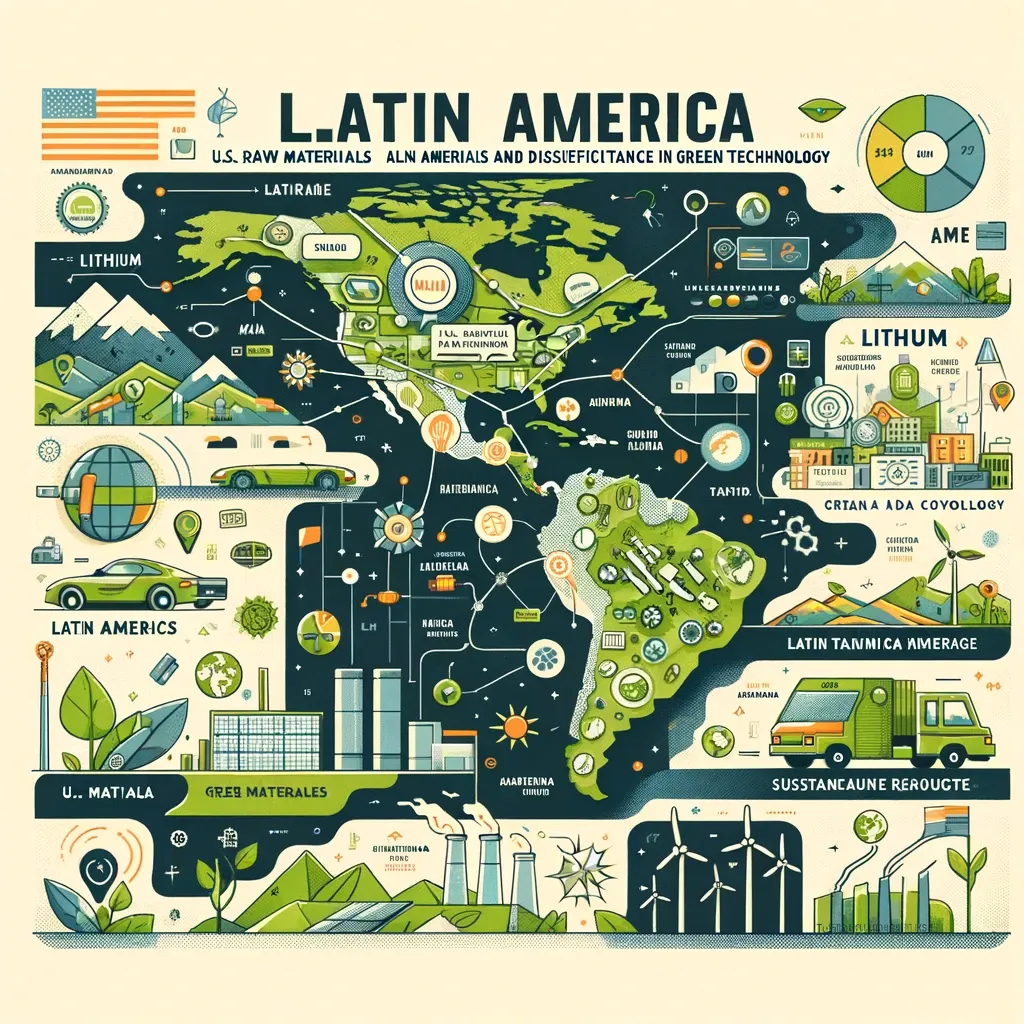Empowering Sustainability: Harnessing Each Latin American Country's Unique Green-Tech Potential
Unleashing Green-Tech Potential Across Latin America: A Multifaceted Approach to Sustainability
Discover the untapped potential of Latin American countries in the green-tech industry. Learn how each nation's unique strengths in raw materials, geography, and innovation are pivotal in shaping a sustainable future in U.S.-LATAM trade.

Introduction
Latin America, a region rich in biodiversity and cultural diversity, holds immense potential in leading the green-tech revolution. This article explores how each country in Latin America can leverage its unique strengths to contribute significantly to the burgeoning field of renewable energy and sustainability, particularly in the context of U.S.-LATAM trade.
Did you know?
Did you know that U.S. Small and Medium Enterprises (SMEs) can tap into a goldmine of opportunities in Latin America by leveraging AI Marketing, specifically aligned with the unique green-tech potential of each Latin American country? For instance, AI-driven marketing tools are revolutionizing how U.S. businesses approach sustainability projects in Latin America. These tools can analyze vast amounts of data to identify specific green-tech needs and opportunities in different regions, allowing SMEs to tailor their offerings precisely.
One innovative way AI Marketing assists is through customized content translation and localization. By employing advanced AI algorithms, U.S. SMEs can ensure that their marketing content resonates culturally and linguistically with each target market in Latin America. This approach is not just about translating words but adapting the sustainability message in a way that aligns with local values and needs, dramatically increasing the likelihood of market penetration and customer acquisition.
Moreover, AI Marketing can identify emerging trends and consumer preferences in real-time, enabling U.S. businesses to adjust their strategies quickly. For example, if solar technology is gaining traction in Brazil while wind energy is the focus in Argentina, AI tools can help SMEs pivot their marketing efforts accordingly. This level of agility is crucial in the rapidly evolving sector of green technology.
Lastly, AI-driven platforms can optimize online advertising campaigns across Latin America, ensuring that U.S. SMEs' sustainable products and services reach the right audience with minimal expenditure. By harnessing the power of AI for targeted, efficient, and culturally aligned marketing, U.S. SMEs can not only contribute to sustainability in Latin America but also unlock lucrative business opportunities in the green-tech sector.
Bolivia: Lithium for the Green Revolution
Bolivia's vast lithium reserves are crucial for battery technology, a cornerstone of the green-tech industry. Responsibly mining and processing lithium can position Bolivia as a key player in the global renewable energy market.
Brazil: The Bioenergy Behemoth
Brazil stands as a global leader in bioenergy, thanks to its extensive sugarcane plantations and advanced ethanol production technology. By investing in biofuels and biomass energy, Brazil can continue to reduce its carbon footprint while bolstering its economy.
Chile: The Solar Powerhouse
Chile's vast Atacama Desert offers the perfect conditions for solar energy production. With high solar irradiance and government support for renewable energy, Chile is poised to become a leading exporter of solar energy in the region.
Argentina: Wind Energy's Frontier
Argentina's lengthy coastline and Patagonian plains present enormous opportunities for wind energy. Capitalizing on these geographic advantages, Argentina can become a significant player in wind energy, creating sustainable energy solutions and job opportunities.
Colombia: Hydropower and Geothermal Excellence
Colombia's topographical diversity, including mountains and rivers, makes it ideal for hydropower and geothermal energy. Embracing these resources, Colombia can enhance its energy security while maintaining its commitment to environmental conservation.
Mexico: A Leader in Green Technology Innovation
While Mexico has made strides in green technology, there's room to grow, particularly in solar and wind energy. Strengthening university-industry collaborations can propel Mexico to the forefront of green-tech innovation, benefiting both the economy and the environment.
Peru: Harnessing the Power of Water and Sun
Peru's diverse geography, from the Andes to the Amazon, offers abundant hydropower and solar energy opportunities. By harnessing these resources, Peru can advance its sustainable energy initiatives while fostering economic growth.
Uruguay: Small but Mighty in Renewable Energy
Despite its small size, Uruguay has made significant progress in renewable energy, particularly wind and solar power. Continuing these efforts, Uruguay can become a model for sustainable energy development in Latin America.
Costa Rica: Pioneering Sustainability
Costa Rica's commitment to sustainability is evident in its goal to become carbon neutral. Investing in renewable energy sources like solar, wind, and geothermal can further solidify its position as a global leader in environmental conservation.
Ecuador: Geothermal and Solar Synergy
Ecuador's volcanic landscape is ideal for geothermal energy, while its equatorial location offers excellent solar energy potential. Exploiting these resources can significantly contribute to Ecuador's sustainable energy portfolio.
Panama: The Gateway to Green Energy
Panama's strategic location and canal infrastructure offer unique opportunities for green-tech logistics and trade. By investing in renewable energy, Panama can strengthen its role in sustainable U.S.-LATAM trade.
Paraguay: A Leader in Hydropower
Paraguay stands out in Latin America for its exceptional use of hydropower. Home to the Itaipu Dam, one of the world's largest hydroelectric facilities, Paraguay is a testament to the power of renewable energy sources. The country's rivers, particularly the Paraguay and Paraná, are pivotal in its energy strategy. Paraguay has the potential to further expand its hydropower capabilities, which can significantly contribute to the regional green energy grid.
Venezuela: Harnessing Solar and Hydroelectric Potential
Venezuela, with its abundant sunlight and extensive river systems, is primed for development in solar and hydroelectric power. The country's geographic location near the equator provides it with a high solar irradiance, ideal for large-scale solar farms. Additionally, Venezuela's vast river networks, including the iconic Orinoco, offer significant opportunities for hydroelectric projects. By focusing on these renewable resources, Venezuela can not only address its energy needs but also contribute to regional sustainability efforts in the U.S.-LATAM trade context. Embracing green technology can aid Venezuela in economic recovery, fostering a more sustainable and resilient future.
Honduras: Embracing Geothermal Energy
Honduras's volcanic landscape offers a promising avenue for geothermal energy development. Geothermal energy, harnessed from the heat stored beneath the Earth's surface, provides a reliable and sustainable energy source. Honduras can capitalize on this resource to diversify its energy portfolio, reduce dependence on fossil fuels, and enhance energy security.
Nicaragua: Pioneering in Wind and Geothermal Energy
Nicaragua, enriched with a unique blend of natural resources, is well-positioned to be a leader in wind and geothermal energy within Latin America. The country's long coastline along the Pacific Ocean and Lake Nicaragua creates an ideal environment for wind energy development. With consistent and strong winds, particularly in regions like Rivas, Nicaragua has the potential to expand its wind energy infrastructure significantly.
Furthermore, Nicaragua's volcanic landscape is a prime asset for geothermal energy development. The country's numerous active volcanoes, such as San Cristóbal and Concepción, provide a potent source of geothermal power. This renewable energy source offers a sustainable and reliable alternative to traditional fossil fuels.
Guatemala: Leveraging Hydropower and Biomass Energy
Guatemala, with its rich natural resources and diverse topography, is poised to make significant strides in renewable energy, particularly in hydropower and biomass energy. The country's numerous rivers and streams, flowing from its mountainous regions, provide ample opportunities for hydropower generation. Guatemala's potential in hydropower is underutilized, offering a path for sustainable energy development that can meet both domestic needs and contribute to regional energy trade.
Additionally, Guatemala has a substantial agricultural sector, which produces a significant amount of organic waste. This biomass can be transformed into a valuable energy resource. By developing biomass energy facilities, Guatemala can turn agricultural byproducts into renewable energy, reducing waste and generating power in an eco-friendly manner.
El Salvador: Advancing in Geothermal Power
El Salvador's volcanic terrain is a valuable asset for geothermal energy production. The country is already home to one of the largest geothermal plants in Central America, located at the Ahuachapán and Berlin fields. Expanding geothermal energy production can provide a stable and sustainable source of power, reducing reliance on imported fossil fuels.
Dominican Republic: A Hub for Wind Energy Development
Wind energy presents a substantial opportunity for the Dominican Republic. The consistent winds along its coastline, especially in regions like the Samaná Peninsula, provide ideal conditions for wind farms. By investing in wind energy infrastructure, the Dominican Republic can tap into this renewable resource to generate clean energy, bolstering its renewable energy portfolio.
Cuba: Biomass Energy from Sugarcane
Cuba's strong sugarcane industry presents an opportunity for biomass energy production. Sugarcane bagasse, a byproduct of sugar production, can be converted into bioenergy. This not only adds value to the agricultural sector but also provides a sustainable energy source.
Puerto Rico: Wind Energy - Harnessing the Caribbean Breezes
The consistent Caribbean trade winds present an excellent opportunity for wind energy in Puerto Rico. The island can capitalize on this by developing wind farms in strategically chosen locations. Wind energy, as a complement to solar power, can contribute to a diversified and balanced renewable energy mix. This approach not only supports environmental sustainability but also provides economic benefits through job creation in the green technology sector.

Enhancing Cross-Border Collaboration
For Latin America to fully realize its green-tech potential, enhanced collaboration with the U.S. is essential. This includes joint ventures in renewable energy projects, technology transfers, and investment in sustainable infrastructure.
Conclusion
The diverse landscapes and resources of Latin American countries present a mosaic of opportunities in the green-tech sector. By leveraging their unique strengths and fostering collaboration, these nations can lead in renewable energy and sustainability, benefiting both the environment and their economies.




























